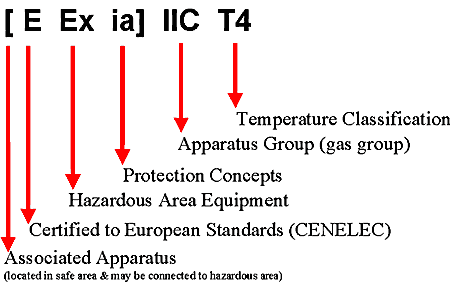ATEX ve AMERİKAN STANDARTLARINA GÖRE Ex İŞARETLEME

| Europe/IEC/CENELEC/NEC505 | Continuous Hazard
>1000hrs/yr |
Intermittent Hazard
10-1000hrs/yr |
Hazard under abnormal conditions 0.1-10hrs/yr |
| North
America/NEC500-503 |
Zone 0(Zone 20 dust) |
Zone 1(Zone 21 dust) |
Zone 2(Zone 22 dust) |
| Safety Categories -
Vapours |
Division
1(gases&dusts) |
Division 1(gases&dusts) |
Division 2(gases&dusts) |
| Safety Categories -
Dusts |
G1 | G2 | G3 |
| D1 | D2 | D3 |
Hazard Category ::
|
Hazardous Substances |
APPARATUS | CLASSIFICATION | |
| Europe | North America NEC 500-503 | Ignition Energy | |
| Methane | Group I(mines) | Class I, Group D | >260 microJoules |
| Gases and Vapours Acetylene Hydrogen Ethyl Propane |
Group IIC Group IIC or IIB Group IIB Group IIA |
Class I, Group A Class I, Group B Class I, Group C Class I, Group D |
>20 microJoules >20 microJoules >60 microJoules >180 microJoules |
| Dusts Metal Dust Coal Dust Grain Dust |
In Preparation In Preparation In Preparation |
Class II, Group E Class II, Group F Class II, Group G |
More ^ Easily ^ Ignited ^ |
| Fibres and Flyings Wood, paper or cotton fibre processing |
Not Classified | Class III | - |
|
MAXIMUM TEMPERATURE |
||
Deg. C |
IEC60079-0 T CLASS |
NORTH AMERICA NEC 500-3(d) |
|
450 |
T1 |
T1 |
|
300 |
T2 |
T2 |
|
280 |
T2 |
T2 A |
|
260 |
T2 |
T2 B |
|
230 |
T2 |
T2 C |
|
215 |
T2 |
T2 D |
|
200 |
T3 |
T3 |
|
180 |
T3 |
T3 A |
|
165 |
T3 |
T3 B |
|
160 |
T3 |
T3 C |
|
135 |
T4 |
T4 |
|
120 |
T4 |
T4 A |
|
100 |
T5 |
T5 |
|
85 |
T6 |
T6 |
| European Practice | Zone | ATEX Cat. | CENELEC EN | IEC 60079 | American Practice | Division | General Characteristics |
| Category 1G | 50284 | -26 | Permits combined methods of protection | ||||
| General Requirements | 50014 | 0 | Basic electrical requirements | ||||
| Oil-immersion Ex"o" | 1, 2 | 2, 3 | 50015 | -6 | Oil-immersion | 1, 2 | Suitable for transformers and where there are moving parts. |
| Pressurisation Ex"p" | 1, 2 | 2, 3 | 50016 | -2 | Purging | 1, 2 | Suitable for cabinets, motors, analysers or working area. Requires specific alarm systems. |
| Powder-filling Ex"q" | 1, 2 | 2, 3 | 50017 | -5 | Not Recognised | Suitable for weighing machines and where there are non-moving parts. | |
| Flameproof Ex"d" | 1, 2 | 2, 3 | 50018 | -1 | Explosion- proof | (1), 2 | Suitable for dc motors. Relatively easy to be applied but with specific mechanical requirements. |
| Increased Safety Ex"e" | 1, 2 | 2, 3 | 50019 | -7 | Not Recognised | Suitable for non sparking apparatus during normal operation. (Terminals, connectors, lamp sockets, induction motors etc.) | |
| Intrinsic Safety Ex"ia" | 0, 1, 2 | 1, 2, 3 | 50020 | -11 | Intrinsic Safety | 1, 2 | Suitable for process instruments. Low energy, safe with 2 faults. |
| Intrinsic Safety Ex"ib" | 1, 2 | 2, 3 | 50020 | -11 | Not Recognised | Suitable for displays. Low energy, safe with 1 fault. | |
| Intrinsically safe systems | 50039 | -25 | Considers combination of intrinsically safe apparatus | ||||
| Type "n" | 2 | 3 | 50021 | -15 | Non-Incendive | 2 | Alternative to standard types of protection. |
| Encapsulation Ex"m" | 1, 2 | 2, 3 | 50028 | -18 | Not Recognised | Suitable for solenoid valves and small circuits and windings. | |
| Special Ex"s" | (0), 1, 2 | See NEC Section 90-4 | For apparatus for which safety can be demonstrated, but not according to any standard method. | ||||